Detecting a fever quickly and easily with these best ear thermometers.

Nowadays fever is not a reason to go to the doctor, but you should keep an eye on it. This is best done with the best ear thermometer, because it is user-friendly and reliable!
In this article you can read how to use an ear thermometer, what you should pay attention to when purchasing an ear thermometer, and read our review about the 5 best ear thermometers in the market.
Ear thermometer buying guide: how to select the best ear thermometer?
In the hospital, not only a heart rate monitor, saturation monitor and blood pressure monitor are indispensable, the best thermometer is too! All these devices measure your most important vital functions and it is therefore advisable to pay close attention to this yourself.
Now I can imagine that you don’t go to the hospital every time for a measurement and that you might not buy a heart rate monitor if you are unfamiliar with heart complaints, but fever happens to everyone sometimes.
Your body temperature is a good indication of your health and you can easily check this with a thermometer.
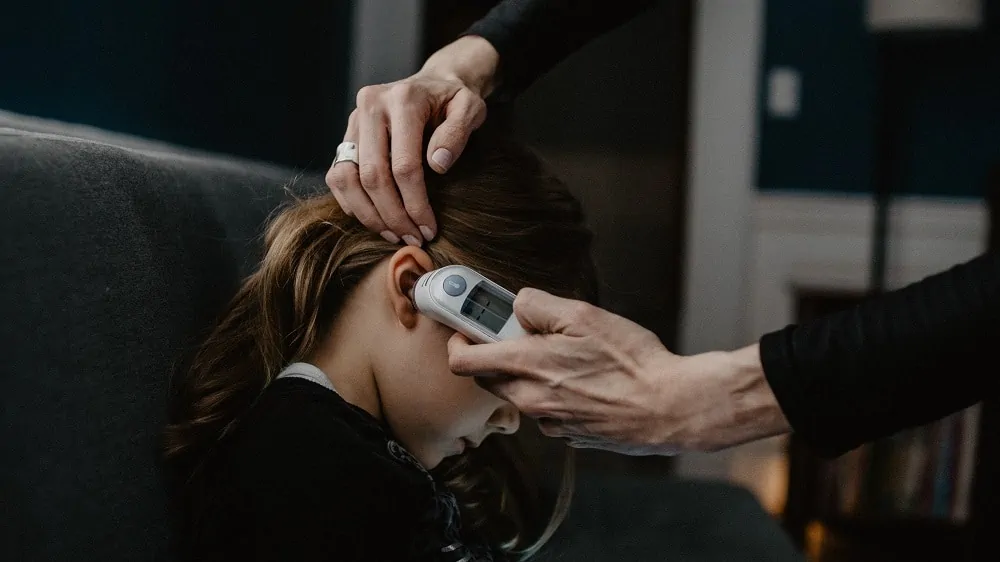
An ear thermometer does this quickly, easily and painlessly. Only there is a lot of difference between the ear thermometers in terms of accuracy, functions and price. Don’t worry, in this buying guide I’ll go through everything with you to ensure that you get the best ear thermometer in the future.
How does an ear thermometer work?
An ear thermometer measures the temperature in your ear. To be more precise, an ear thermometer measures the temperature of your eardrum. The eardrum is linked to the hypothalamus – the system that keeps your body in balance and the center of your temperature regulation.
The eardrum has the same blood flow as the hypothalamus. Changes in body temperature, such as in fever, are more detectable at the eardrum than elsewhere in the body.
The eardrum radiates heat radiation: infrared. This is not visible radiation, it’s radiation with a wavelength that is invisible to the eye. This light manifests itself in heat. The sensor (the lens) of the ear thermometer picks up this radiation and converts it into a digital value for body temperature.
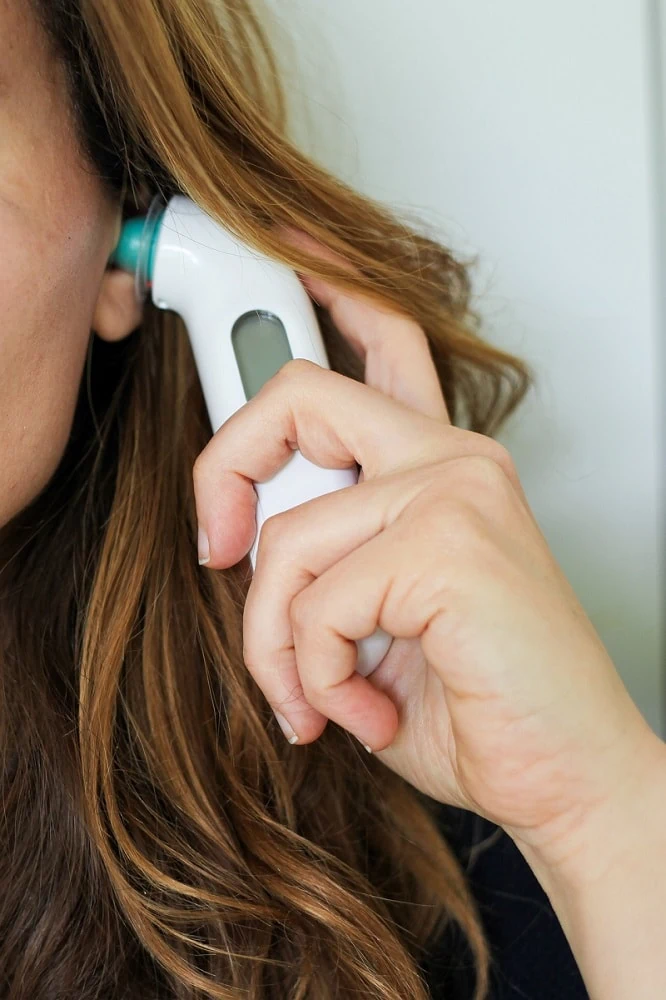
There is quite a complicated process behind measuring body temperature with an ear thermometer, but you just follow the steps below.
- Clean the ear.
- Pull the ear slightly back and slightly upwards.
- Place the ear thermometer in the ear canal and aim the sensor at the eardrum.
- Press the button and wait for the measurement to finish, and that’s it!
Simple, huh? There are some factors to take into account, because they influence the result, for example, but I will tell you more about that later.
Why should you use an ear thermometer?
As mentioned above, body temperature is most detectable at the eardrum. In combination with the correct use, this leads to a very accurate measurement.
Rectal is still the most reliable way to measure body temperature, but this is not necessarily the best way. This can be quite inconvenient, and as with any digital thermometer, it takes a while to complete the reading which makes it all the more annoying.
An ear thermometer is an infrared thermometer. The advantage of any infrared thermometer is that the measurement is quick and easy.
The advantage of an ear thermometer compared to a forehead thermometer (also an infrared thermometer) is that an ear thermometer is even more accurate.
The disadvantages of ear thermometers are that they are not suitable for use with babies younger than 3 months, that they are more difficult to use with sleeping or moving children and that they are uncomfortable with an ear infection.
Fortunately, there is a solution for this: a forehead measurement. A number of ear thermometers – usually the better ones – measure not only the temperature of the ear, but also that of the forehead. You then immediately have a good forehead thermometer at hand if the ear measurement is not applicable.
Reliability and accuracy
Ear thermometers are very accurate and reliable, but you may have noticed by now that this strongly depends on the correct use.

Proper use starts with a clean sensor (also called a lens). The sensor of the thermometer measures the temperature. Dirt or damage on the sensor influences the result of the measurement.
Cleaning the ear thermometer after use and a cover (also known as a lens cap, lens filter or protective cover) help with this.
This is also the reason that you should clean the ear before use. Earwax has an insulating effect and prevents the sensor from seeing the eardrum properly.
The natural curvature of the ear canal also prevents the sensor from seeing the eardrum properly. That is why you pull the ear slightly back and up during the measurement. This straightens the ear canal, making the eardrum easily accessible to the sensor.
Moreover, it is important that you perform the measurement under ‘normal’ conditions. If you lay on your ear for a long time or had something over your ear such as a hat, your ear is warmer. A very hot or very cold environment also influences the measurement.
Also take the temperature into account when storing. Ear thermometers require thermal stability. This means that it is best to store the thermometer in a place with a stable temperature that does not differ much from the ambient temperature of the place where you measure.
Remember: Correct use differs per thermometer, so read the manual carefully.
Certificates and multiple scans
There are ear thermometers that work extra accurately. These usually have certain certificates and quality marks that show that the ear thermometer is also used in hospitals. These thermometers have a maximum deviation of 0.2°C and are very accurate.
Typically, these ear thermometers perform multiple scans during the measurement. The measured result is then the average of several scans, which in turn contributes to reliability.
The CE marking is one of the most important markings. This marking indicates that the product meets the legal (safety) requirements and especially if you put something in your ear, that is a nice fact.
Hygiene
The hygiene of an ear thermometer is important. Firstly because it is not nice to get someone else’s wax in your ear, secondly because a clean ear thermometer measures more accurately and thirdly because it limits the spread of germs among multiple users.
Cover caps
Some ear thermometers come with disposable caps. This is very hygienic because you use a new cap for every person and every measurement, but you also have to buy new caps every time, which is not good for your wallet and the environment.
There are also reusable caps. You still need to clean these, but make sure that the lens (sensor) is not damaged.
Water resistance
If there is no cover, it is important to clean the ear thermometer properly. A waterproof ear thermometer makes this just that little bit easier. You can easily clean these under the tap.
A splash-proof thermometer cannot be submerged in water, but can be cleaned with a damp cloth.
If an ear thermometer is water resistant, the thermometer has an IP certification. The IP value consists of two digits, the first digit expressing protection against contact and dust and the second expressing protection against water. The higher the number, the better the protection.
Measure response time, measuring range and additional temperatures
Infrared thermometers perform the temperature measurement the fastest of all thermometers. The rate at which the thermometer completes the measurement is the response time.
While most ear thermometers have a response time of three seconds or less, it varies between one and five seconds.
This is a short time anyway and in most cases those few seconds make no difference, but if, for example, your child dreads a measurement and moves a lot, a shorter response time does make a difference.

The measuring range of an ear thermometer is more important. This is the total range the thermometer can measure. A measuring range between 20°C and 45°C is more than sufficient for measuring body temperature, otherwise I strongly doubt whether you are human.
Some ear thermometers are – in addition to measuring body temperature – also able to measure the ambient temperature or liquid temperature. You use this, for example, to measure the temperature of the milk for your child or the temperature of the corner where the baby’s bed is located.
When the ear thermometer has the function to measure the other temperatures, a larger measuring range is important. In that case, a measuring range between 0°C and 100°C is ideal.
Memory function
More and more thermometers have a memory function. With the memory function you save the results of previous measurements. How many measurements you store depends on the number of memory locations.
Saving and reviewing the previous measurements gives you the opportunity to see if the body temperature fluctuates or stays the same during the illness period. It is also possible to determine your average body temperature and health.
There are thermometers with different user profiles, so you can save the measurements of each user separately.
About fever: In the past, the standard healthy temperature was 37°C, you had a fever at 38 °C and you had an elevation if you were in between. Today this theory appears to be outdated.
The average body temperature has decreased and differs per person. By taking several measurements at times when you feel good, you can find out your average body temperature. If you have an increase from 1°C above your average body temperature, you have a fever.
Smart ear thermometer
Smart devices can no longer be ignored, so it is not surprising that smart ear thermometers also exist.

You can connect these smart thermometers to an app with Bluetooth. In these apps you save your previous measurements. The advantage of this is that there are no limited number of memory locations.
Some apps are more extensive and give you the option to enter factors such as medication taken and give you a notification to take a new measurement. This way you get a more complete picture of the course of your illness and you can estimate whether your temperature may have dropped because of the medication.
These comprehensive apps usually also provide advice based on your temperature and symptoms. This will give you an idea of what the possible cause is, but if you are concerned or if the fever lasts for a long time, it is always wise to see a doctor.
Fever alert
A fever warning indicates whether there is a normal body temperature, an elevated body temperature or a fever by means of colors or a tone indication. There are even models that determine this based on your previous measurements.
You can easily explain the fever warning with colors to your children and a tone indication is nice for the visually impaired.
Display
You can read the measurement on the display. The larger the screen, the easier it is to read. Large and clear numbers also help with legibility. An illuminated screen contributes to legibility in the dark.
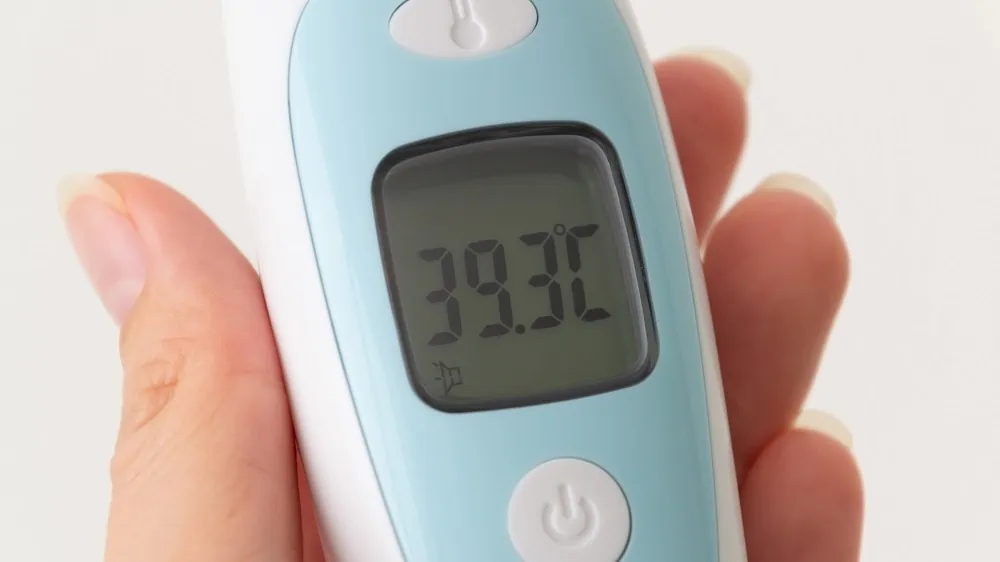
Beep sound
A beep sound when the measurement is done is very useful, especially if you are taking the measurement on yourself. It is not possible to look at the display during the measurement. A beep that sounds when the measurement is complete lets you know when it’s time to remove the thermometer from your ear.
Battery (duration)
Most good ear thermometers have a battery life of more than two years, but check the battery life in advance. It’s annoying when you have to replace the batteries every other month.
Also check whether the thermometer gives a message when the batteries are almost empty. This way you prevent the batteries from running out when you need the thermometer. Feeling sick three times is nothing, but if you also have to go out, it’s completely terrible.
Celsius and Fahrenheit
In many countries, people usually use degrees Celsius (°C). Most ear thermometers on the market therefore show the temperature in degrees Celsius. Pay close attention to this, because in some cases a thermometer measures in degrees Fahrenheit (°F).
Recommend the 5 best ear thermometers
1. Braun IRT 6520 ThermoScan 7 thermometer

Fever sound signal: Yes
CE marking: Visible
Additional thermometer functions: Measure ambient temperature
Sound signal at end of measurement: Yes
Location of measurement: Forehead, Ear
Waterproof: No
2. Protective caps
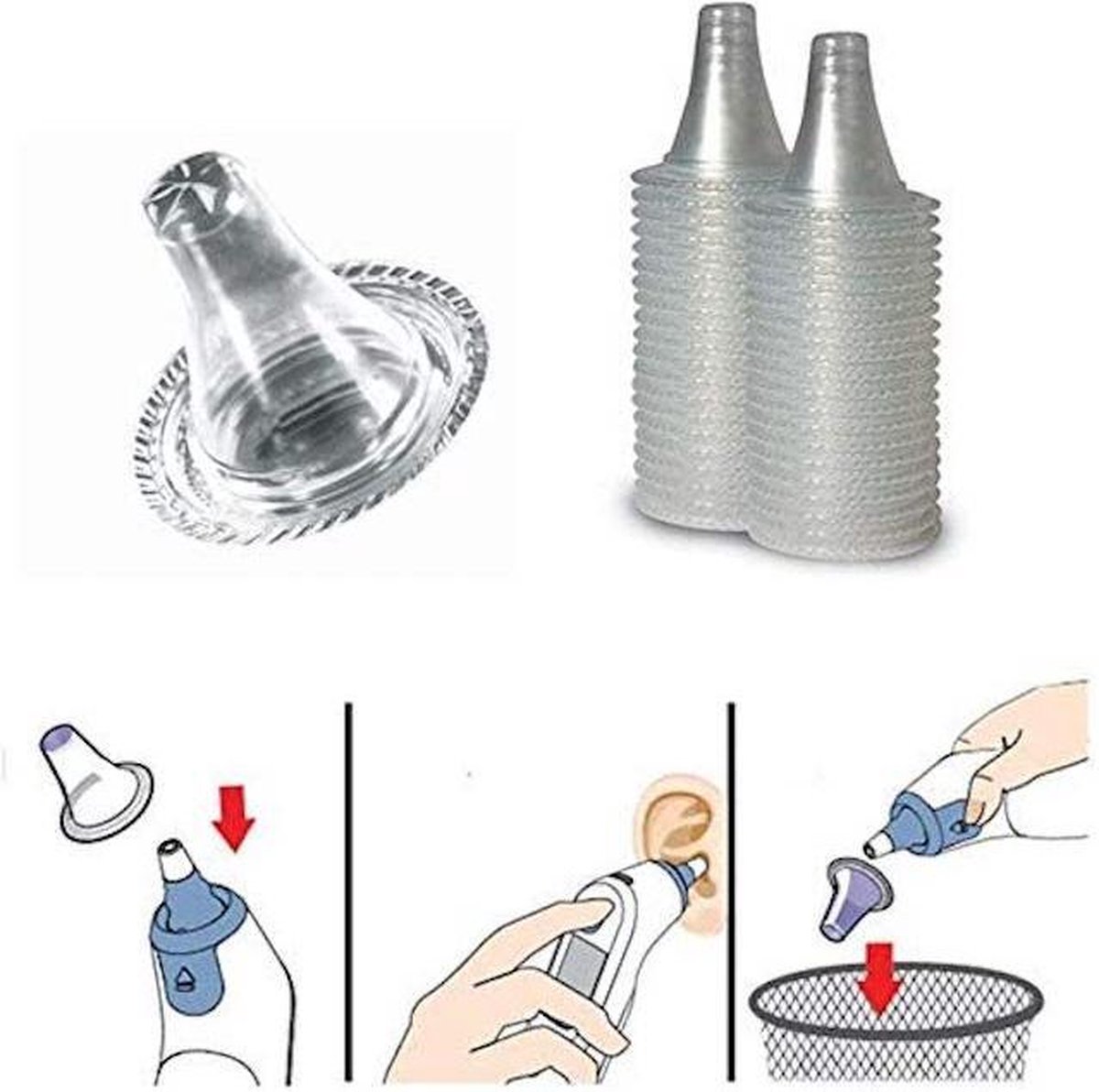
Sound signal in case of fever: No
Additional thermometer functions: Measure ambient temperature
Sound signal at end of measurement: Yes
Location of measurement: Ear
Waterproof: Yes
3. Bintoi® XE200
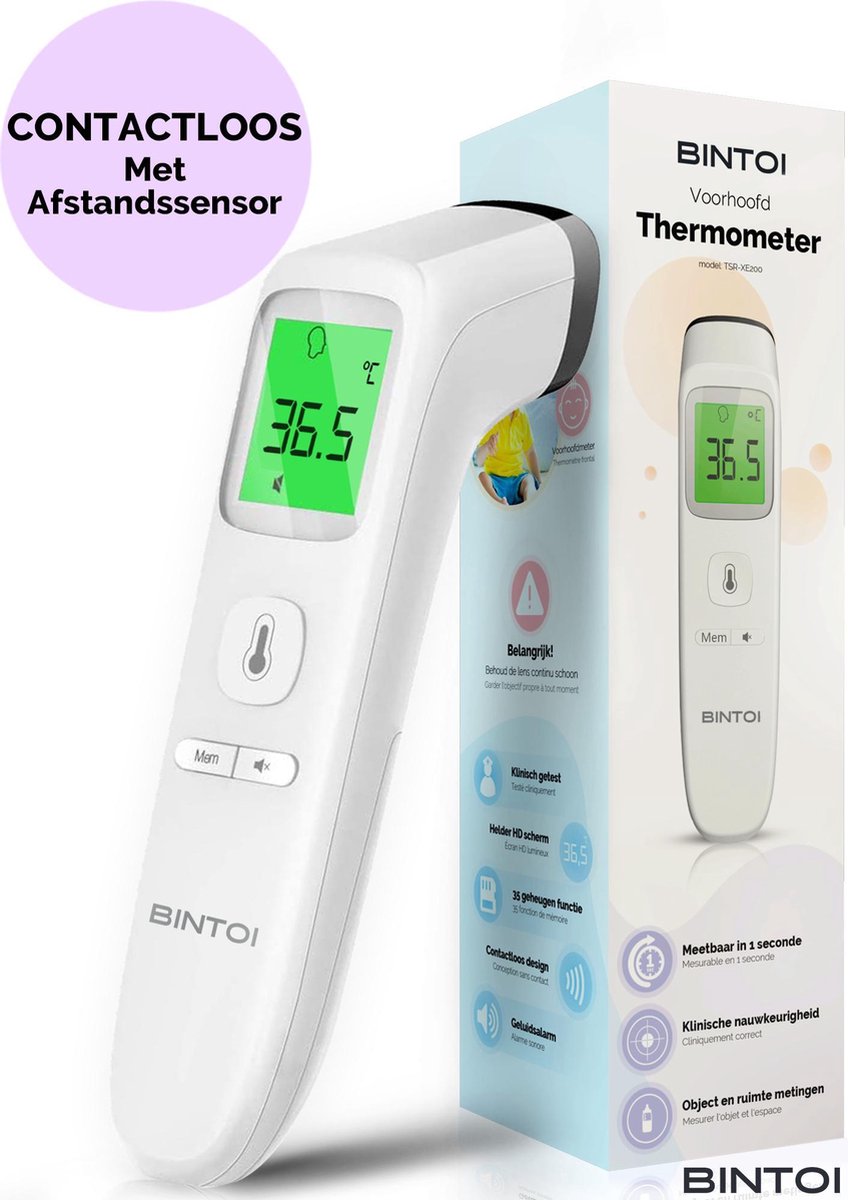
Fever sound signal: Yes
CE marking: Visible
Additional thermometer functions: Measure temperature of liquids, Measure temperature surfaces, Measure ambient temperature
Sound signal at end of measurement: Yes
Location of measurement: Forehead, Ear
Waterproof: No
4. Braun IRT 3030
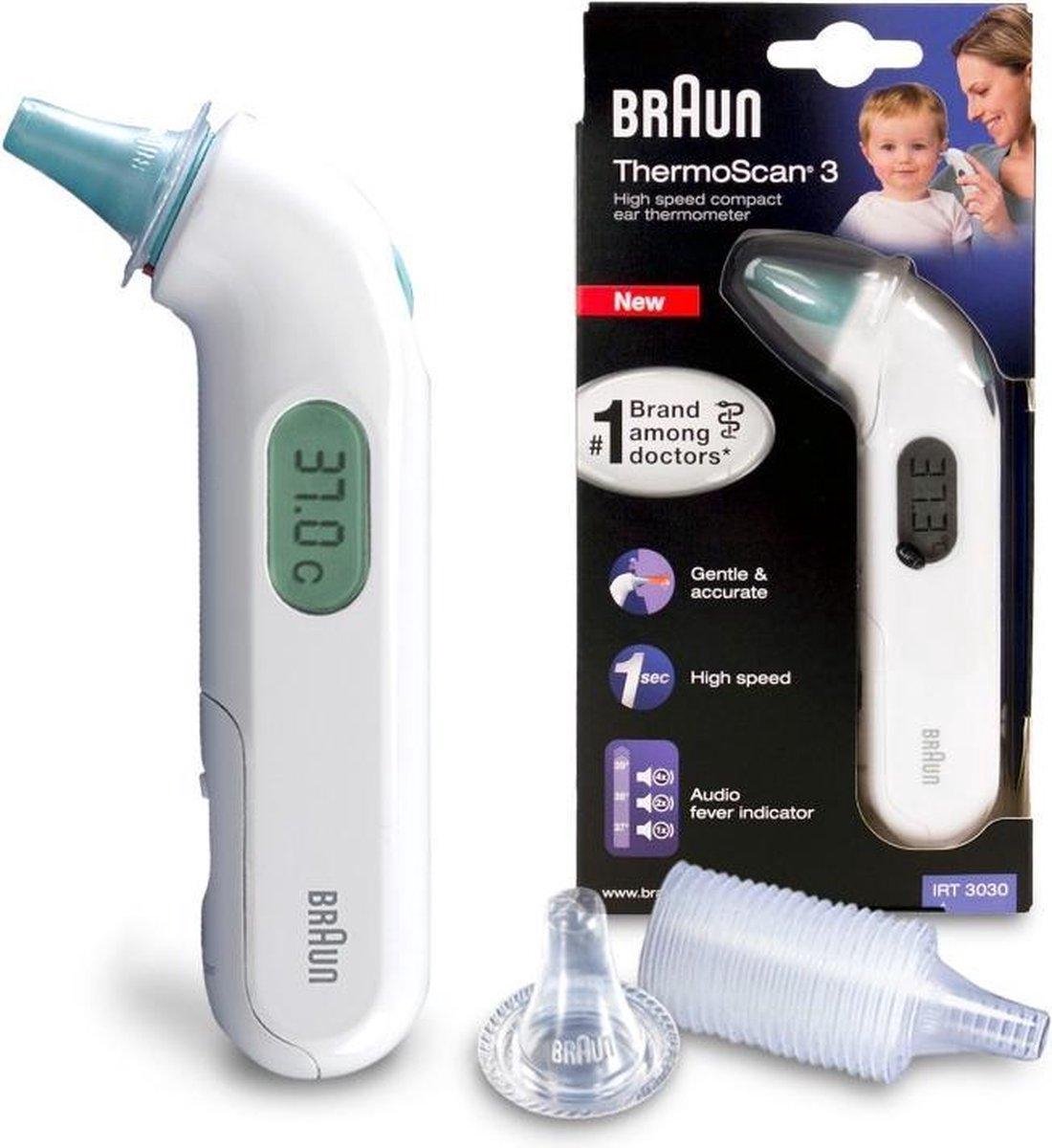
Fever sound signal: Yes
Additional thermometer functions: Measure ambient temperature
Sound signal at end of measurement: Yes
Location of measurement: Ear
Waterproof: Yes
5. Bintoi® X200
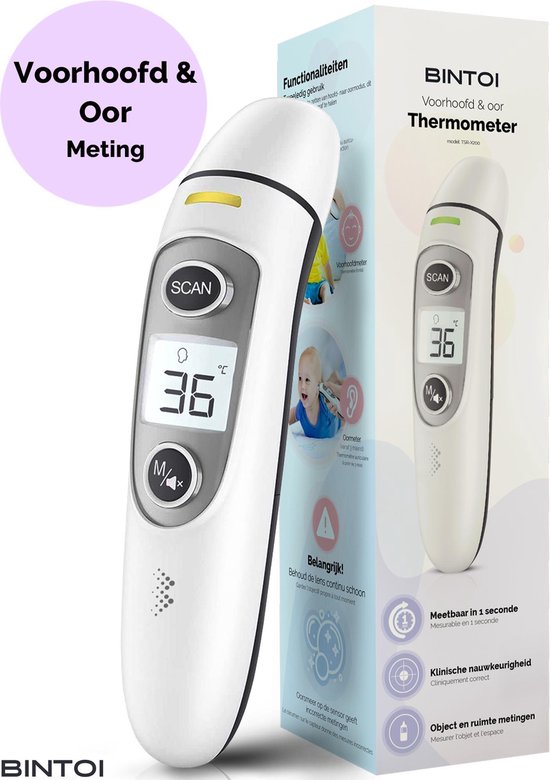
Fever sound signal: Yes
CE marking: Visible
Additional thermometer functions: Measure temperature of liquids, Measure temperature surfaces, Measure ambient temperature
Sound signal at end of measurement: Yes
Location of measurement: Forehead, Ear
Waterproof: No
Frequently asked questions about ear thermometers
Hopefully all your answers are in the buying guide. If not, I hope your question is answered below.
– From what age is an ear thermometer applicable?
An ear thermometer is not suitable for use on babies younger than three months. This is because their ear canal is still very narrow. This prevents the sensor from reaching the eardrum. This works well with older babies and children, but it is important to work precisely and carefully.
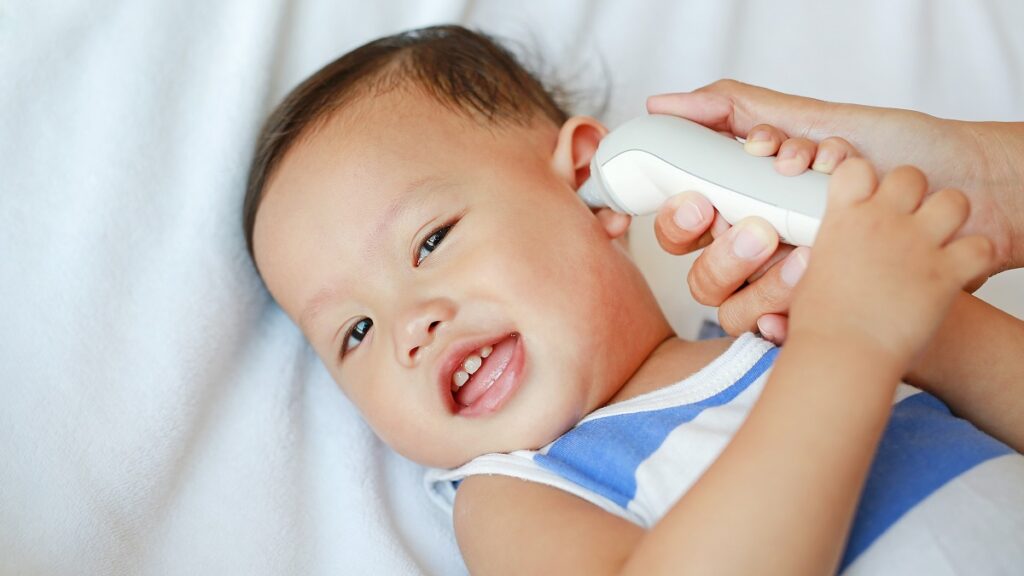
– How do you clean an ear thermometer?
If there is a reusable cover, clean it under the tap with soapy water or disinfectant. Is there no cover? Then you clean the thermometer yourself. If it is waterproof, you can do this under the tap with mild soapy water or with disinfectant, otherwise use a damp cloth.
– How much does an ear thermometer cost?
The prices of ear thermometers range from 15 to 200 euros. Most ear thermometers cost between 25 and 50 euros. Up to 50 euros, the statement “cheap is expensive” usually applies, and you pay for the functions and accuracy. Above 50 euros you soon pay unnecessarily much.
– Which ear thermometer should I buy?
That’s entirely up to you and your budget; everyone is unique. What I do have for you is a handy table with – in my opinion – the most important specifications of the best ear thermometers. This is how you make the best choice!
| Sound signal in case of fever | CE marking | Sound signal at end of measurement | Location of measurement | Waterproof | ||
|---|---|---|---|---|---|---|
| 1 | Braun IRT 6520 ThermoScan 7 thermometer | Yes | Visible | Yes | Forehead, Ear | No |
| 2 | Protective caps | No | Visible | Yes | Ear | Yes |
| 3 | Bintoi® XE200 | Yes | Visible | Yes | Forehead, Ear | No |
| 4 | Braun IRT 3030 | Yes | Visible | Yes | Ear | Yes |
| 5 | Bintoi® X200 | Yes | Visible | Yes | Forehead, Ear | No |
Conclusion
The next time you feel sick, grab your ear thermometer and it will tell you in no time whether you have a fever or not. It doesn’t matter which ear thermometer you use for this, but one is faster and more accurate than the other. Moreover, there are a lot of useful functions to choose from.
It just depends on what you prefer and hopefully that is now clear after reading the buying guide. Maybe your future ear thermometer is in the list above. Thank you for reading.